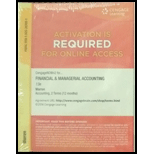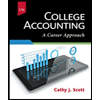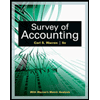
Concept explainers
(a)
Bank reconciliation: Bank statement is prepared by bank. The company maintains its own records from its perspective. This is why the cash balance per bank and cash balance per books seldom agree. Bank reconciliation is the statement prepared by company to remove the differences and disagreement between cash balance per bank and cash balance per books.
Debit and credit rules:
- Debit an increase in asset account, increase in expense account, decrease in liability account, and decrease in
stockholders’ equity accounts. - Credit decrease in asset account, increase in revenue account, increase in liability account, and increase in stockholders’ equity accounts.
To prepare: Bank reconciliation of Company SI as at July 31, 2016
(a)
Answer to Problem 7.5BPR
Prepare bank reconciliation of Company SI as at July 31, 2016.
| Company SI | ||
| Bank Reconciliation | ||
| July 31, 2016 | ||
| Particulars | Amount ($) | Amount ($) |
| Cash balance as per bank statement | 11,601.41 | |
| Add: | ||
| Deposit of July 31, not recorded by bank | 1,177.84 | |
| Less: Outstanding checks | ||
| No : 613 | 137.50 | |
| No : 628 | 837.70 | |
| No : 633 | 310.08 | 1,285,.28 |
| Adjusted cash balance per bank | 11,494.00 | |
| Cash balance as per books | 7,664.00 | |
| Add: | ||
| Notes and interest receivable collected by bank | 4,160.00 | |
| Error in July 23 deposit | 18.00 | |
| Error in recording check no.627 | 63.00 | 4,241.00 |
| Less: | ||
| Checks returned because of insufficient funds | 375.00 | |
| Bank service charges | 36.00 | 411.00 |
| Adjusted cash balance per books | 11,494.00 | |
Table (1)
Working Notes:
Determine the balance per company’s book, June 30
Explanation of Solution
- The deposits which are not recorded by the bank are referred to as deposits in transit. Since the deposits in transit are not reflected on the bank statement, the company should add deposits in transit to cash balance per bank, while preparation of
bank reconciliation statement . - Outstanding checks are the checks that are issued by the company, but not yet paid by the bank. When the check is issued for payment, the company deducts the cash balance immediately. But the bank deducts only when the cash is paid for the issued check. So, company deducts the cash balance per bank to remove the differences.
- Notes receivable being collected by bank, is credited to bank account. But the company is not aware of it. So, while preparing bank reconciliation statement, company should add the amount to the cash balance per books.
- Error in recording checks and banks deducting service charge for the services rendered like lock box rental, or printed checks. But the company is not aware of such deductions. So, company deducts the cash balance per books while bank reconciliation preparation.
(b)
To prepare:
(b)
Explanation of Solution
Prepare journal entry to record account receivable collected by bank.
| Date | Account Titles and Description | Ref. | Debit ($) | Credit ($) | |
| July | 31 | Cash | 4,241.00 | ||
| Notes Receivable | 4,000 | ||||
| Interest Revenue | 160.00 | ||||
| Sales | 18.00 | ||||
| Accounts payable | 63.00 | ||||
| (To record receivable collected by bank) | |||||
Table (2)
Description:
- Cash is an asset account. The amount is increased because bank collected note receivable, and an increase in assets should be debited.
- Notes Receivable is an asset account. The amount has decreased because the amount to be received is collected by the bank, and, a decrease in assets should be credited.
- Interest revenue is a revenue account and increases the stockholders’ equity. Thus, increases in the stockholders’ equity should be credited.
- Sales is revenue and increases the stockholders’ equity. So, credit the same.
- Accounts payable is a liability and decreased as there is receipt of cash. So, credit accounts payable account.
Prepare journal entry to record book error amount.
| Date | Accounts and Description | Post Ref. | Debit ($) | Credit ($) | |
| June | 30 | Accounts receivables | 375.00 | ||
| Miscellaneous expenses | 36.00 | ||||
| Cash | 411.00 | ||||
| (To record amount under-payable by accountant) | |||||
Table (3)
Description:
- Accounts receivable is an asset account. It is increased and thus, current asset is increased and debited.
- Miscellaneous expenses are expenses account and decrease the stockholders’ equity. Thus, decrease in the stockholders’ equity should be debited.
- Cash is an asset account. The amount is decreased to pay the under-paid check, and a decrease in asset is credited.
(c)
To report: Amount of cash in the
(c)
Explanation of Solution
Thus, the adjusted balance from the bank reconciliation should be reported as cash on the July 31 balance sheet for SI is $11,494.00
(d)
To explain: The error to be included in the bank reconciliation.
(d)
Explanation of Solution
Error amount of $1,610 ($1,800 – $180) is the cancelled check. It is added in the “balance according to bank statement” on the bank reconciliation statement. Thus, the cancelled checks are being presented in the bank. When the check is presented to the bank, bank balance is corrected.
Want to see more full solutions like this?
Chapter 7 Solutions
CengageNOWv2, 2 terms Printed Access Card for Warren?s Financial & Managerial Accounting, 13th, 13th Edition
- In addition to your explanation, address the following self-reflection questions: How does the WH Framework help you analyze the situation? Now that I've put together the framework, how does the WH Framework help managers with making business decisions? And What type of decisions would the WH Framework chart help make as a manager?arrow_forwardPlease provide the accurate answer to this general accounting problem using valid techniques.arrow_forwardPlease provide the answer to this general accounting question using the right approacharrow_forward
- Can you demonstrate the accurate method for solving this financial accounting question?arrow_forwardCan you solve this general accounting problem using appropriate accounting principles?arrow_forwardPlease explain the solution to this general accounting problem with accurate principles.arrow_forward
- I am looking for a step-by-step explanation of this financial accounting problem with correct standards.arrow_forwardI need help solving this general accounting question with the proper methodology.arrow_forwardReba Dixon is a fifth-grade school teacher who earned a salary of $37,080 in 2024. She is 45 years old and receives $1,200 of alimony payments each month from her former husband (divorced in 2016). Reba also rents out a small apartment building. This year Reba received $54,600 of rental payments from tenants, and she incurred $19,500 of expenses associated with the rental. Reba and her daughter Heather (20 years old at the end of the year) moved to Georgia in January of this year. Reba provides more than one-half of Heather's support. They had been living in Colorado for the past 15 years, but ever since her divorce, Reba has been wanting to move back to Georgia to be closer to her family. Luckily, last December, a teaching position opened up and Reba and Heather decided to make the move. Reba paid a moving company $2,470 to move their personal belongings, and she and Heather spent two days driving the 1,820 miles to Georgia. Reba rented a home in Georgia. Heather decided to continue…arrow_forward
- Boston Industries completes job #842, which has a standard of 840 labor hours at a standard rate of $22.75 per hour. The job was completed in 890 hours, and the average actual labor rate was $23.10 per hour. What is the labor efficiency (quantity) variance? (A negative number indicates a favorable variance and a positive number indicates an unfavorable variance.)arrow_forwardPlease explain the solution to this general accounting problem with accurate principles.arrow_forwardI am looking for the correct answer to this general accounting question with appropriate explanations.arrow_forward
 College Accounting (Book Only): A Career ApproachAccountingISBN:9781337280570Author:Scott, Cathy J.Publisher:South-Western College Pub
College Accounting (Book Only): A Career ApproachAccountingISBN:9781337280570Author:Scott, Cathy J.Publisher:South-Western College Pub Survey of Accounting (Accounting I)AccountingISBN:9781305961883Author:Carl WarrenPublisher:Cengage Learning
Survey of Accounting (Accounting I)AccountingISBN:9781305961883Author:Carl WarrenPublisher:Cengage Learning Excel Applications for Accounting PrinciplesAccountingISBN:9781111581565Author:Gaylord N. SmithPublisher:Cengage Learning
Excel Applications for Accounting PrinciplesAccountingISBN:9781111581565Author:Gaylord N. SmithPublisher:Cengage Learning Financial And Managerial AccountingAccountingISBN:9781337902663Author:WARREN, Carl S.Publisher:Cengage Learning,Century 21 Accounting Multicolumn JournalAccountingISBN:9781337679503Author:GilbertsonPublisher:Cengage
Financial And Managerial AccountingAccountingISBN:9781337902663Author:WARREN, Carl S.Publisher:Cengage Learning,Century 21 Accounting Multicolumn JournalAccountingISBN:9781337679503Author:GilbertsonPublisher:Cengage





